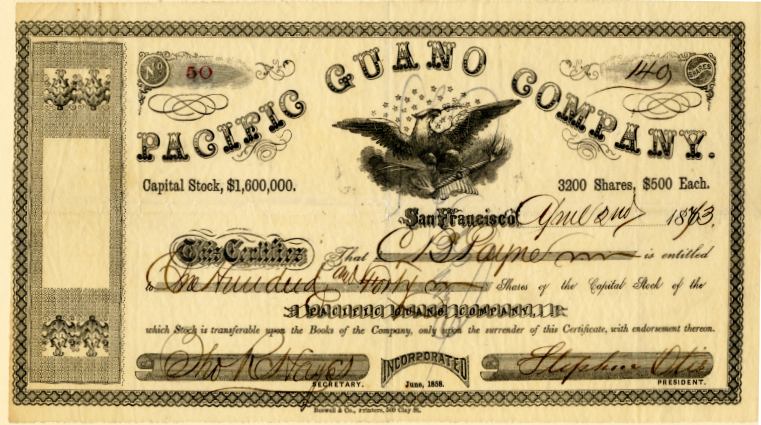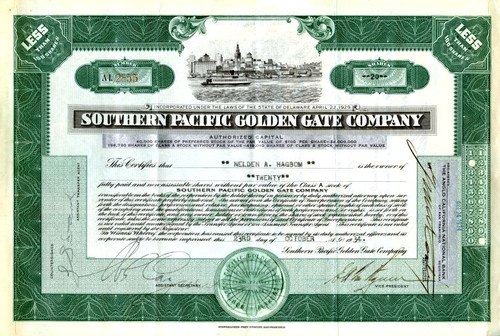Beautiful certificate from the Pacific Guano Company issued in 1873. This historic document has an ornate border around it with a vignette of an eagle. This item has the signatures of the Company's President and Secretary. 
Certificate In March 1859 Johnston Island (Johnston Atoll) was formally claimed by the newly formed Pacific Guano Company, a corporation formed in California to ship guano direct to the west coast,68 almost immediately involving the United States in brief conflict with the fledgling government of the Kingdom of Hawaii. Standing alone one thousand miles southwest of Honolulu, Johnston was visited three months later by a vessel bearing the flag of Hawaii. The American flags and crosses symbolic of American ownership were torn down, and the land was reclaimed in the name of King Kamehameha IV and Hawaiian sovereignty reasserted. It was but a trifling footnote to history, the parlous state of Hawaii's own independence in the late 1850s rendering futile such a gesture, and the Pacific Guano Company proceeded without interruption to market the guano. Boston's Daily Mercury lauded the acquisition of Johnston Island, emphasizing how "singularly fortunate" the nation was to have "obtained the lion's share in these valuable islands."69 Before the year was out, huge improvements had been effected at Johnston Island, now shown to be really two islands, one about fifty acres in size and the other about thirty.70 Guano was estimated to be about three to four feet deep on the larger island on which a wharf, some five hundred feet long, had been built along with a railroad track to the diggings. The conflict over ownership was speedily resolved when the company was able to prove to the United States attorney general that its ownership had been "actual, continuous, exclusive" from the time of its discovery. Johnston Atoll, also known as Kalama Atoll to Native Hawaiians, is an unincorporated territory of the United States currently administered by the United States Fish and Wildlife Service (USFWS) of the Department of the Interior as part of the Pacific Remote Islands Marine National Monument. The islands are visited annually by the U.S. Fish and Wildlife Service. Public entry is only by special-use permit and generally restricted to scientists and educators. The atoll is currently under the control of the American military. It has been used as a bird sanctuary, as a naval refueling depot, as an airbase, for nuclear and biological weapons testing, for space recovery, as a secret missile base, and as a chemical weapon and Agent Orange storage and disposal site. These activities left the area environmentally contaminated and remediation and monitoring continue. Johnston Atoll is located between the Marshall Islands and the Hawaiian Islands Johnston Atoll is an uninhabited 1,300 ha (3,200 acres) atoll in the North Pacific Ocean located about 750 nmi (860 mi; 1,390 km) southwest of the island of Hawai'i and is grouped as one of the United States Minor Outlying Islands. The atoll, which is located on a coral reef platform, has four islands. Johnston (or Kalama) Island and Sand Island are both enlarged natural features, while Akau (North) and Hikina (East) are two artificial islands formed by coral dredging.[1] By 1964, dredge and fill operations had increased the size of Johnston Island to 596 acres (241 ha) from its original 46 acres (19 ha), also increased Sand Island from 10 to 22 acres (4.0 to 8.9 ha), and added two new islands, North and East of 25 and 18 acres (10.1 and 7.3 ha). The four islands compose a total land mass of 2.67 km². Due to the atoll's tilt, much of the reef on the southeast portion has subsided. But even though it does not have an encircling reef crest, the reef crest on the northwest portion of the atoll does provide for a shallow lagoon, with depths ranging from 310 m (9.832.8 ft). The climate is tropical but generally dry. Northeast trade winds are consistent and there is little seasonal temperature variation.[1] With elevation ranging from sea level to 5 m (16 ft) at Summit Peak, the islands contain some low-growing vegetation and palm trees on mostly flat terrain and no natural fresh water resources. The unofficial flag of Johnston Atoll was flown below the Stars and Stripes. The double bird holding 4 stars represents both the Air Force and the Fish and Wildlife Service, while the four stars denote the atoll's islands; the white is for coral and the aquamarine for the surrounding ocean. The first Western record of the atoll was on September 2, 1796 when the Boston-based American brig Sally accidentally grounded on a shoal near the islands. The ship's captain, Joseph Pierpont, published his experience in several American newspapers the following year giving an accurate position of Johnston and Sand Island along with part of the reef. However, he did not name or lay claim to the area.[4] The islands were not officially named until Captain Charles J. Johnston of the Royal Naval ship HMS Cornwallis sighted them on December 14, 1807. In the following years, an occasional vessel stopped, but generally one look was enough. The Guano Islands Act, enacted on August 18, 1856, was federal legislation passed by the U.S. Congress that enabled citizens of the U.S. to take possession of islands containing guano deposits. In 1858 William Parker and R. F. Ryan, chartered the schooner Palestine specifically to find Johnston Atoll. They located guano on the atoll in March 1858 and they proceeded to claim the island under the Guano Islands Act. By 1858, Johnston Atoll was claimed by both the United States and the Kingdom of Hawaii. In June 1858, Samuel Allen, sailing on the Kalama, tore down the U.S. flag and raised the Hawaiian flag renaming the atoll Kalama. The larger island was renamed Kalama Island, and the nearby smaller island was called Cornwallis. Returning on July 27, 1858, the Captain of the Palestine again hoisted the American flag and reasserted the rights of the United States. The same day, the atoll was declared part of the domain of King Kamehameha IV.[5] On this visit however the Palestine left two crew members on the island to gather phosphate. While Palestine was at the atoll and these two men were still on the island, a July 27, 1858 proclamation of Kamehameha IV declared the annexation of this island to Hawaii stating that it was "derelict and abandoned." However, later that year King Kamehameha revoked the lease granted to Samuel Allen when the King learned that the atoll had been claimed previously by the United States.[6] However, this did not prevent the Hawaiian Territory from making use of the Atoll or asserting ownership. By 1890 the atoll's guano deposits had been almost entirely depleted (mined out) by U.S. interests operating under the Guano Islands Act. In 1892, HMS Champion made a survey and map of the island, hoping that it might be suitable as a cable station. On January 16, 1893, the Hawaiian Legation at London reported a diplomatic conference over this temporary occupation of the island. However, the Kingdom of Hawaii was overthrown on January 17, 1893. When in 1898 Hawaii became an integral part of the United States during the SpanishAmerican War, the name of Johnston Island was omitted from the list of Hawaiian Islands. On September 11, 1909, Johnston was leased by the Territory of Hawaii to a private citizen for fifteen years. A board shed was built on the southeast side of the larger island, and a small tramline run up onto the slope of the low hill, to facilitate the removal of guano. Apparently neither the quantity nor the quality of the guano was sufficient to pay for gathering it so that the project was soon abandoned. History from Wikipedia, Encyberpedia and OldCompany.com (old stock certificate research service)

Certificate








